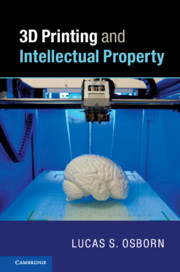Book contents
- 3D Printing and Intellectual Property
- Reviews
- 3D Printing and Intellectual Property
- Copyright page
- Contents
- Acknowledgments
- Abbreviations
- Introduction
- 1 3D Printing Technology’s Capabilities and Effects
- 2 How 3D Printing Works and Why it Matters
- 3 Primer on Intellectual Property Law
- 4 Can You Patent a 3D Printable File? (and Why it Matters)
- 5 Patents – Direct Infringement, Individual Infringement, and “Digital” Infringement
- 6 Patents – Indirect Infringement and Intermediaries
- 7 3D Printing and Trademarks: The Dissociation Between Design and Manufacturing
- 8 Creativity and Utility: 3D Printable Files and the Boundary Between Copyright and Patent Protection
- 9 Design Rights, Tangibility, and Free Expression
- 10 DMFs and Optimizing Innovation Incentives
- Conclusion
- Index
8 - Creativity and Utility: 3D Printable Files and the Boundary Between Copyright and Patent Protection
Published online by Cambridge University Press: 24 July 2019
- 3D Printing and Intellectual Property
- Reviews
- 3D Printing and Intellectual Property
- Copyright page
- Contents
- Acknowledgments
- Abbreviations
- Introduction
- 1 3D Printing Technology’s Capabilities and Effects
- 2 How 3D Printing Works and Why it Matters
- 3 Primer on Intellectual Property Law
- 4 Can You Patent a 3D Printable File? (and Why it Matters)
- 5 Patents – Direct Infringement, Individual Infringement, and “Digital” Infringement
- 6 Patents – Indirect Infringement and Intermediaries
- 7 3D Printing and Trademarks: The Dissociation Between Design and Manufacturing
- 8 Creativity and Utility: 3D Printable Files and the Boundary Between Copyright and Patent Protection
- 9 Design Rights, Tangibility, and Free Expression
- 10 DMFs and Optimizing Innovation Incentives
- Conclusion
- Index
Summary
Chapter 8 focuses on a specific issue created by 3D printing technology: whether DMFs of purely (or primarily) utilitarian objects should receive copyright protection. Tangible objects dominated by utilitarian concerns do not receive copyright protection. Neither should the corresponding DMF, I argue. This novel argument has attracted criticism, but I defend it as a matter of doctrine and policy. Doctrinally, I argue that U.S. law excludes copyright protection not only for useful articles, but also for designs of (i.e., the shape of) useful articles, even if depicted in a two-dimensional drawing. Moreover, most jurisdictions around the world extend copyright protection only to works containing creativity, and I argue that DMFs of utilitarian objects contain no copyrightable creativity – they are exact, uncreative representations of the unprotected tangible objects. As a matter of policy, allowing copyright protection for DMFs of useful articles would cause copyright law, which is geared toward aesthetic works, to trespass on patent law, which is geared toward utilitarian works. In short, granting these DMFs copyright protection would inhibit the progress of utilitarian innovation.
- Type
- Chapter
- Information
- 3D Printing and Intellectual Property , pp. 143 - 177Publisher: Cambridge University PressPrint publication year: 2019



